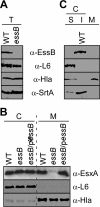Characterization of EssB, a protein required for secretion of ESAT-6 like proteins in Staphylococcus aureus
- PMID: 23006124
- PMCID: PMC3489787
- DOI: 10.1186/1471-2180-12-219
Characterization of EssB, a protein required for secretion of ESAT-6 like proteins in Staphylococcus aureus
Abstract
Background: Staphylococcus aureus secretes EsxA and EsxB, two small polypeptides of the WXG100 family of proteins. Genetic analyses have shown that production and secretion of EsxA and EsxB require an intact ESAT-6 Secretion System (ESS), a cluster of genes that is conserved in many Firmicutes and encompasses esxA and esxB . Here, we characterize EssB, one of the proteins encoded by the ESS cluster. EssB is highly conserved in Gram-positive bacteria and belongs to the Cluster of Orthologous Groups of protein COG4499 with no known function.
Results: By generating an internal deletion in essB , we demonstrate that EssB is required for secretion of EsxA. We use a polyclonal antibody to identify EssB and show that the protein fractionates with the plasma membrane of S. aureus . Yet, when produced in Escherichia coli, EssB remains mostly soluble and the purified protein assembles into a highly organized oligomer that can be visualized by electron microscopy. Production of truncated EssB variants in wild-type S. aureus confers a dominant negative phenotype on EsxA secretion.
Conclusions: The data presented here support the notion that EssB may oligomerize and interact with other membrane components to form the WXG100-specific translocon in S. aureus .
Figures





Similar articles
-
Secretion of atypical protein substrates by the ESAT-6 secretion system of Staphylococcus aureus.Mol Microbiol. 2013 Nov;90(4):734-43. doi: 10.1111/mmi.12395. Epub 2013 Oct 4. Mol Microbiol. 2013. PMID: 24033479 Free PMC article.
-
Isolation of a Membrane Protein Complex for Type VII Secretion in Staphylococcus aureus.J Bacteriol. 2017 Oct 31;199(23):e00482-17. doi: 10.1128/JB.00482-17. Print 2017 Dec 1. J Bacteriol. 2017. PMID: 28874412 Free PMC article.
-
Characterization of Staphylococcus aureus EssB, an integral membrane component of the Type VII secretion system: atomic resolution crystal structure of the cytoplasmic segment.Biochem J. 2013 Jan 15;449(2):469-77. doi: 10.1042/BJ20121209. Biochem J. 2013. PMID: 23098276 Free PMC article.
-
Structure and regulation of the type VI secretion system.Annu Rev Microbiol. 2012;66:453-72. doi: 10.1146/annurev-micro-121809-151619. Epub 2012 Jun 28. Annu Rev Microbiol. 2012. PMID: 22746332 Free PMC article. Review.
-
New insights into the distribution of WXG100 protein secretion systems.Antonie Van Leeuwenhoek. 2011 Feb;99(2):127-31. doi: 10.1007/s10482-010-9507-4. Epub 2010 Sep 19. Antonie Van Leeuwenhoek. 2011. PMID: 20852931 Review.
Cited by
-
The transmembrane domain of the Staphylococcus aureus ESAT-6 component EssB mediates interaction with the integral membrane protein EsaA, facilitating partially regulated secretion in a heterologous host.Arch Microbiol. 2018 Sep;200(7):1075-1086. doi: 10.1007/s00203-018-1519-x. Epub 2018 May 8. Arch Microbiol. 2018. PMID: 29737367 Free PMC article.
-
Secretion of atypical protein substrates by the ESAT-6 secretion system of Staphylococcus aureus.Mol Microbiol. 2013 Nov;90(4):734-43. doi: 10.1111/mmi.12395. Epub 2013 Oct 4. Mol Microbiol. 2013. PMID: 24033479 Free PMC article.
-
Isolation of a Membrane Protein Complex for Type VII Secretion in Staphylococcus aureus.J Bacteriol. 2017 Oct 31;199(23):e00482-17. doi: 10.1128/JB.00482-17. Print 2017 Dec 1. J Bacteriol. 2017. PMID: 28874412 Free PMC article.
-
Reducing the Bottleneck in Discovery of Novel Antibiotics.Microb Ecol. 2017 Apr;73(3):658-667. doi: 10.1007/s00248-016-0889-3. Epub 2016 Nov 28. Microb Ecol. 2017. PMID: 27896376
-
EssD, a Nuclease Effector of the Staphylococcus aureus ESS Pathway.J Bacteriol. 2016 Dec 13;199(1):e00528-16. doi: 10.1128/JB.00528-16. Print 2017 Jan 1. J Bacteriol. 2016. PMID: 27795323 Free PMC article.
References
-
- Dalbey RE, Wickner W. Leader peptidase catalyzes the release of exported proteins from the outer surface of the Escherichia coli plasma membrane. J Biol Chem. 1985;260:15925–15931. - PubMed
Publication types
MeSH terms
Substances
Grants and funding
LinkOut - more resources
Full Text Sources
Molecular Biology Databases

